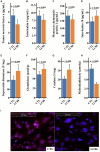Lacticaseibacillus paracasei LC86 mitigates age-related muscle wasting and cognitive impairment in SAMP8 mice through gut microbiota modulation and the regulation of serum inflammatory factors
- PMID: 38873561
- PMCID: PMC11169942
- DOI: 10.3389/fnut.2024.1390433
Lacticaseibacillus paracasei LC86 mitigates age-related muscle wasting and cognitive impairment in SAMP8 mice through gut microbiota modulation and the regulation of serum inflammatory factors
Abstract
Purpose: Chronic inflammation contributes to the decline in muscle strength and cognitive abilities associated with aging. This study aims to clarify the effects of oral administration of Lacticaseibacillus paracasei LC86 on these age-related declines, as well as its impact on the composition of gut microbiota.
Methods: Senescence-accelerated mouse prone 8 (SAMP8) mice received a 12 week regimen of LC86 (1 × 109 CFU/day). Muscle strength was assessed through forelimb grip strength and four-limb hanging tests. Cognitive function was evaluated through behavioral performance tests, and changes in gut microbiota were analyzed.
Results: Administration of LC86 significantly enhanced muscle strength, demonstrated by increased grip strength and higher glycogen content in the gastrocnemius muscle (p = 0.041, p = 0.017, and p = 0.000, respectively). Behavioral tests suggested that LC86 mitigated age-related cognitive decline. Furthermore, there was a significant decrease in serum pro-inflammatory cytokines, such as IL-6, TNF-α, and MCP-1 (p = 0.002, p = 0.000, and p = 0.005, respectively), and an elevation in the anti-inflammatory cytokine IL-10 level (p = 0.000). An increase in hepatic antioxidant capacity was observed. Significant changes in the gut microbiota composition were noted, including increased populations of Bifidobacterium and Lactobacillus and decreased levels of Escherichia/Shigella and Bacteroides.
Conclusion: The findings suggest that LC86 supplementation mitigates muscle weakness and cognitive impairment in aging SAMP8 mice, potentially through the modulation of inflammation and gut microbiota composition. LC86 emerges as a promising candidate for ameliorating the decline of muscular and cognitive functions associated with aging.
Keywords: Lacticaseibacillus paracasei LC86; cognitive impairment; gut microbiota; inflammatory factors regulation; muscle wasting.
Copyright © 2024 Cai, Dong, Han, Jin, Liu, Gai and Zou.
Conflict of interest statement
MJ was employed by Chengxi Biotech. HL and ZG were employed by Wecare Probiotics Co., Ltd. The remaining authors declare that the research was conducted in the absence of any commercial or financial relationships that could be construed as a potential conflict of interest.
Figures







Similar articles
-
Modulation of the gut-bone axis: Lacticaseibacillus paracasei LC86 improves bone health via anti-inflammatory metabolic pathways in zebrafish models of osteoporosis and cartilage damage.Front Immunol. 2025 Apr 16;16:1493560. doi: 10.3389/fimmu.2025.1493560. eCollection 2025. Front Immunol. 2025. PMID: 40308595 Free PMC article.
-
Genome sequence and evaluation of safety and probiotic potential of Lacticaseibacillus paracasei LC86 and Lacticaseibacillus casei LC89.Front Microbiol. 2025 Jan 27;15:1501502. doi: 10.3389/fmicb.2024.1501502. eCollection 2024. Front Microbiol. 2025. PMID: 39931277 Free PMC article.
-
Lactobacillus paracasei PS23 Delays Progression of Age-Related Cognitive Decline in Senescence Accelerated Mouse Prone 8 (SAMP8) Mice.Nutrients. 2018 Jul 12;10(7):894. doi: 10.3390/nu10070894. Nutrients. 2018. PMID: 30002347 Free PMC article.
-
Gut Microbiota, Muscle Mass and Function in Aging: A Focus on Physical Frailty and Sarcopenia.Nutrients. 2019 Jul 17;11(7):1633. doi: 10.3390/nu11071633. Nutrients. 2019. PMID: 31319564 Free PMC article. Review.
-
The Interplay between Gut Microbiota and Cognitive Functioning in the Healthy Aging Population: A Systematic Review.Nutrients. 2024 Mar 15;16(6):852. doi: 10.3390/nu16060852. Nutrients. 2024. PMID: 38542764 Free PMC article.
Cited by
-
Modulation of the gut-bone axis: Lacticaseibacillus paracasei LC86 improves bone health via anti-inflammatory metabolic pathways in zebrafish models of osteoporosis and cartilage damage.Front Immunol. 2025 Apr 16;16:1493560. doi: 10.3389/fimmu.2025.1493560. eCollection 2025. Front Immunol. 2025. PMID: 40308595 Free PMC article.
-
Genome sequence and evaluation of safety and probiotic potential of Lacticaseibacillus paracasei LC86 and Lacticaseibacillus casei LC89.Front Microbiol. 2025 Jan 27;15:1501502. doi: 10.3389/fmicb.2024.1501502. eCollection 2024. Front Microbiol. 2025. PMID: 39931277 Free PMC article.
-
Enhancement of host defense against Helicobacter pylori infection through modulation of the gastrointestinal microenvironment by Lactiplantibacillus plantarum Lp05.Front Immunol. 2025 Jan 17;15:1469885. doi: 10.3389/fimmu.2024.1469885. eCollection 2024. Front Immunol. 2025. PMID: 39896799 Free PMC article.
References
LinkOut - more resources
Full Text Sources
Miscellaneous

